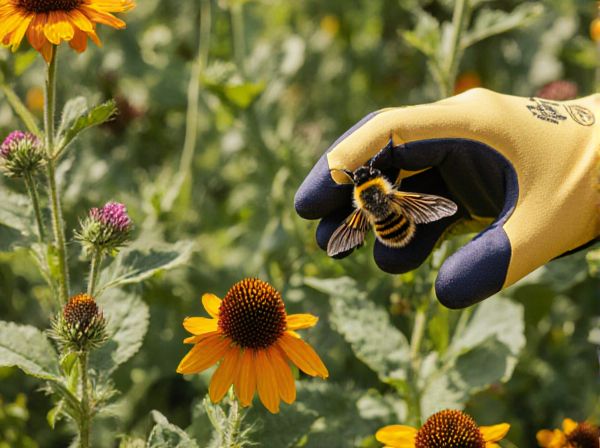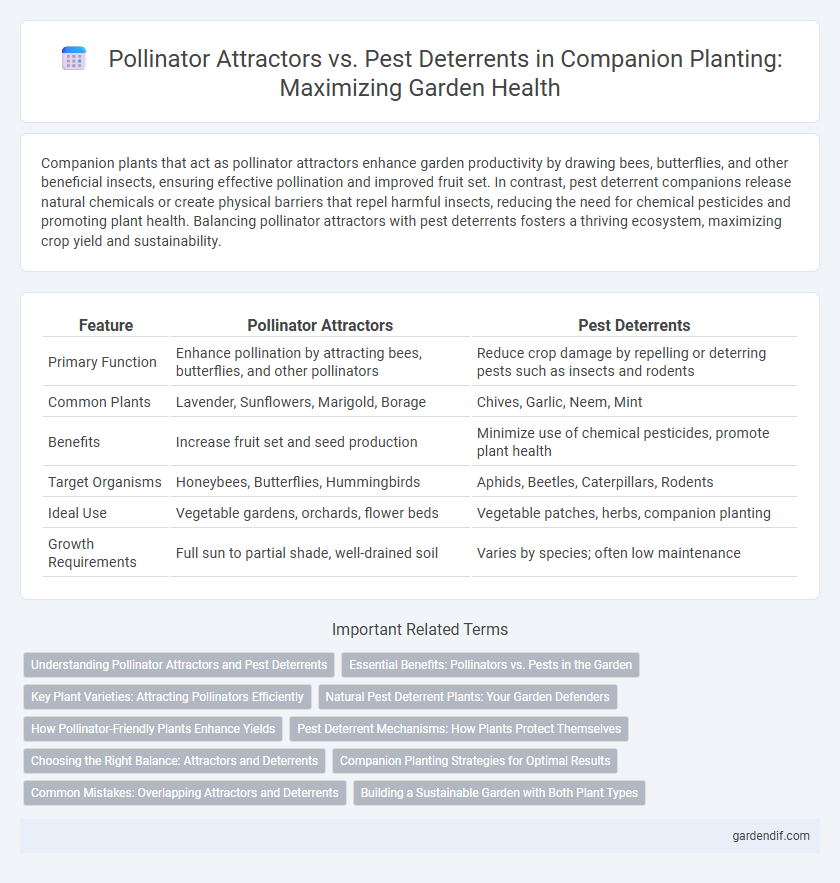
Pollinator attractors vs Pest deterrents Illustration
Companion plants that act as pollinator attractors enhance garden productivity by drawing bees, butterflies, and other beneficial insects, ensuring effective pollination and improved fruit set. In contrast, pest deterrent companions release natural chemicals or create physical barriers that repel harmful insects, reducing the need for chemical pesticides and promoting plant health. Balancing pollinator attractors with pest deterrents fosters a thriving ecosystem, maximizing crop yield and sustainability.
Table of Comparison
| Feature | Pollinator Attractors | Pest Deterrents |
|---|---|---|
| Primary Function | Enhance pollination by attracting bees, butterflies, and other pollinators | Reduce crop damage by repelling or deterring pests such as insects and rodents |
| Common Plants | Lavender, Sunflowers, Marigold, Borage | Chives, Garlic, Neem, Mint |
| Benefits | Increase fruit set and seed production | Minimize use of chemical pesticides, promote plant health |
| Target Organisms | Honeybees, Butterflies, Hummingbirds | Aphids, Beetles, Caterpillars, Rodents |
| Ideal Use | Vegetable gardens, orchards, flower beds | Vegetable patches, herbs, companion planting |
| Growth Requirements | Full sun to partial shade, well-drained soil | Varies by species; often low maintenance |
Understanding Pollinator Attractors and Pest Deterrents
Pollinator attractors such as marigolds, lavender, and sunflowers emit scents and display vibrant colors that effectively draw bees, butterflies, and other beneficial insects essential for plant fertilization and increased crop yield. Pest deterrents like garlic, chives, and nasturtiums produce specific chemical compounds or strong aromas that repel harmful insects including aphids, beetles, and caterpillars, reducing the need for chemical pesticides. Understanding the complementary roles of pollinator attractors and pest deterrents supports sustainable gardening and agriculture by enhancing biodiversity and protecting plants naturally.
Essential Benefits: Pollinators vs. Pests in the Garden
Pollinator attractors such as lavender, marigold, and borage enhance garden productivity by increasing the presence of bees, butterflies, and other beneficial insects essential for plant fertilization and fruit development. Pest deterrents like neem, garlic, and chives naturally repel harmful insects including aphids, beetles, and caterpillars, reducing the need for chemical pesticides and promoting a healthier ecosystem. Balancing pollinator-friendly plants with pest-repellent species optimizes garden health, improves crop yields, and supports biodiversity.
Key Plant Varieties: Attracting Pollinators Efficiently
Lavender, marigold, and bee balm are key plant varieties efficient at attracting pollinators such as bees, butterflies, and hummingbirds, enhancing garden productivity and biodiversity. These plants produce vibrant flowers rich in nectar and pollen, which serve as essential food sources for pollinators, increasing pollination rates for nearby crops. Integrating these attractors strategically boosts ecosystem health and crop yield by fostering natural pollination processes.
Natural Pest Deterrent Plants: Your Garden Defenders
Natural pest deterrent plants such as marigolds, nasturtiums, and basil act as effective garden defenders by emitting scents that repel harmful insects, reducing the need for chemical pesticides. These companion plants enhance pollinator attractors like lavender and borage by maintaining a balanced ecosystem where beneficial insects thrive while pests are kept at bay. Integrating natural pest deterrents promotes healthier crop yields and supports biodiversity in sustainable gardening practices.
How Pollinator-Friendly Plants Enhance Yields
Pollinator-friendly plants, such as lavender, sunflowers, and borage, enhance crop yields by attracting bees, butterflies, and other beneficial insects that improve pollination efficiency. Increased pollinator activity leads to higher fruit set, larger fruits, and improved seed production, directly boosting agricultural productivity. Incorporating diverse pollinator attractors alongside pest deterrents creates a balanced ecosystem that supports plant health and maximizes harvest outcomes.
Pest Deterrent Mechanisms: How Plants Protect Themselves
Plants employ a variety of pest deterrent mechanisms, such as producing toxic secondary metabolites, emitting repellent volatile organic compounds, and developing physical barriers like thorns or sticky trichomes to protect themselves from herbivorous insects. These chemical and structural defenses reduce pest infestation and enhance plant survival without relying on synthetic pesticides. Understanding these natural pest deterrent strategies is crucial for developing sustainable companion planting systems that leverage plants' intrinsic protective abilities.
Choosing the Right Balance: Attractors and Deterrents
Achieving an effective balance between pollinator attractors and pest deterrents is essential for maximizing garden productivity and biodiversity. Selecting companion plants such as marigolds and nasturtiums enhances pollinator visits while simultaneously repelling pests like aphids and whiteflies. Prioritizing native flowering plants that support beneficial insects ensures optimal pollination without compromising pest management.
Companion Planting Strategies for Optimal Results
Companion planting strategies leverage pollinator attractors like marigolds and lavender to enhance crop yield while incorporating pest deterrents such as garlic and chives to protect plants from harmful insects. Utilizing these specific plant combinations creates a balanced ecosystem, reducing the need for chemical pesticides and promoting natural pest control. Maximizing the synergy between pollinator-friendly and pest-repellent companion plants results in healthier crops and improved garden productivity.
Common Mistakes: Overlapping Attractors and Deterrents
Common mistakes in companion planting include selecting plants with overlapping pollinator attractors and pest deterrents, which can confuse beneficial insects and reduce their effectiveness. For example, using multiple species that emit similar floral scents may compete for pollinators, while certain deterrents might inadvertently repel pollinators along with pests. Optimizing plant combinations based on complementary attractant and deterrent profiles enhances pest control and pollination efficiency in the garden ecosystem.
Building a Sustainable Garden with Both Plant Types
Incorporating pollinator attractors such as lavender, bee balm, and sunflowers enhances garden biodiversity by supporting essential insect populations like bees and butterflies. Balancing these with pest deterrents like marigolds, nasturtiums, and garlic minimizes harmful insect activity naturally. Combining diverse companion plants fosters a resilient and sustainable garden ecosystem by promoting pollination while reducing pest damage without chemical inputs.
Pollinator attractors vs Pest deterrents Infographic

 gardendif.com
gardendif.com